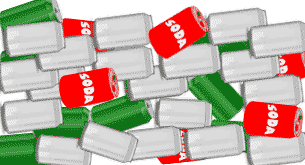Facts about Aluminum (Aka Aluminium)
Teach kids about the material Aluminum
Posted by Admin / in Science Facts
Aluminum, also spelled aluminium in many parts of the world, is a popular material used in many products today. Its most known use is in aluminum beverage cans and aluminum foil. Previously aluminum was used for building materials such as aluminum siding. Using aluminum in siding was replaced with plastics because of lower cost. One of the best properties of aluminum is it ability of recycling. Recycled aluminum is essentially as good as new aluminum. Recycling aluminum is so inexpensive that it is actually cheaper to recycle aluminum than to make new aluminum. Find out more interesting facts kids will enjoy about aluminum.

Aluminum is used to make aluminum soda cans, which are easily recycled to make new things.
Facts about Aluminum
- In 1808, an English scientist named Humphry Davy discovered a metal which he called Aluminum.
- In 1825 a Danish physicist named Hans Christian Orsted successfully isolated aluminum into its true element form.
- Aluminum was added to periodic table with the symbol Al and was named Aluminum. It was later changed to aluminium sound the same (-ium) as other elements. In 1925, the American Chemical Society reverted back to Humphry Davy's original spelling. In many countries, Al is still spelled Aluminium.
- Aluminum is the third most plentiful element.
- Aluminum is the most abundant metal in the Earth's crust.
- Aluminum is the third most plentiful element in the Earth's crust.
- Aluminum metal is made from bauxite ore (AL2O3 . nH2O) and oxides of iron, silicon and titanium.
- New aluminum is made in an electrochemical procedure known as the Bayer process.
- In aluminum, atoms bond in a crystalline structure. This structure gives aluminum its strength.
- Aluminum has a face-centered cubic structure which is a crystal with equal sides and angles of 90 degrees.
- Pure aluminum has a yield strength of 5000 psi (35 Mpa). Pure aluminum is soft and ductile, but not very strong.
- Alloys are added to pure aluminum to increase strength and improve other properties. The alloy names are based on main added material. A number is then designated to the alloy. For pure aluminum, the number is 1xxx, where the last three x's are based on the percentage of aluminum and percentage of additives. The following alloy numbers are used, based on the main alloy ingredient: copper (2xxx), manganese (3xxx), silicon (4xxx), magnesium (5xxx), magnesium and silicon (6xxx), zinc (7xxx) and lithium alloys (8xxx).
- A magnesium and silicon hardened aluminum has a yield strength of 21,000 psi (145 Mpa).
- A copper-hardened aluminum has yield strength of 50,000 psi (345 MPa)
- Heat passes through aluminum very well. This is called thermal conductivity. In fact, heat passes through aluminum more than six times better than stainless steel. This makes aluminum a great metal for heat sinks which help to drain heat away from critical electronics like a processor.
- The high melting temperature and oxide coating makes aluminum difficult to weld together.
- In order to weld aluminum, a high temperature weld using a blanket of inert gas such as argon or helium is used.
- Aluminum foil is made out of aluminum.
- Some people still refer to aluminum foil as tin foil. Metal foil was previously made out of tin, but in the early 1900's tin was replaced with aluminum.
- Aluminum has a high resistance to corrosion
- Aluminum is very ductile. It is easily bent and shaped.
- Aluminum is a good electrical conductor.
- Aluminum is a good thermal conductor.
- Aluminum is easily recycled.
